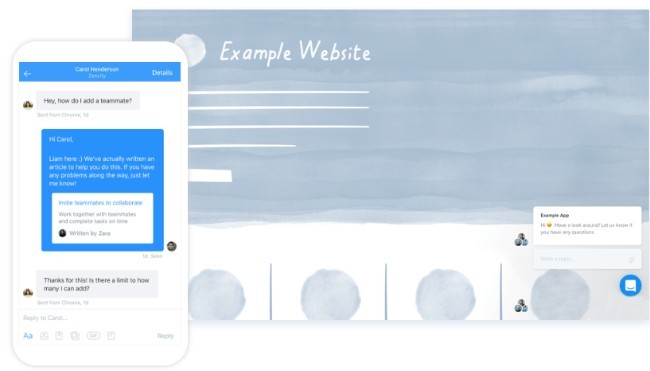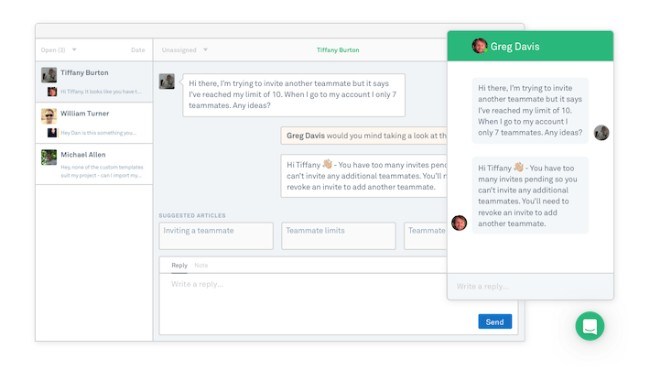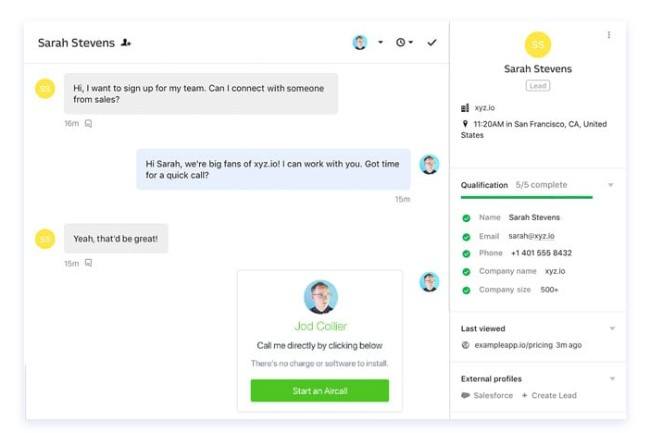At some point in your ecommerce professional career, you're going to feel like you're overwhelmed with leads and customer support requests. Current users, customers, and potential clients are constantly trying to converse with you and your customer support/sales team. That's a good thing, right? Well, sure, if you can handle the load.
The problem is that the leads and user requests come from all over the internet, into your email inbox, on your website, and through social channels–making it difficult to check-in on all platforms. In this Intercom Inbox review, we'll talk about an excellent solution to this problem.
Intercom offers a suite of products for acquiring, engaging, and retaining customers. It brings together several modern tools for marketing, sales, and customer support, and you're able to pick and choose which of the products you want for reasonable pricing.
Intercom provides two products that we won't be reviewing today: Messages and Articles. The first is meant for sending out targeted messages at certain times, while Articles has powerful tools for generating and publishing helpful content to your knowledgebase. Both look promising, but we're focusing on Intercom Inbox, the solution for managing conversations with customers and leads.
Intercom Inbox Review: How Might It Improve Your Ecommerce Business?
Before looking into the primary features from Intercom Inbox, it's important to understand exactly how it might help boost your sales and improve your online business overall.
As we mentioned above, messages come in from all sorts of different places online. This includes social media sites like Facebook and Twitter, along with the multiple email inboxes your organization may have. In addition to that, your company might have user apps. And that's not even including the contact forms, chat boxes, and ticketing systems on your website.
Let's say you have one person on your customer support team and a second person working sales. The customer support rep has to field questions on Facebook, the ticketing system, live chat, and the contact form. The sales person is pretty much in the same boat, and they both have to decipher between which messages are meant for which department.
Overall, your communications system becomes a mess, with multiple platforms and websites being checked on a daily basis. This configuration makes for slower customer service, lost leads, and less than productive employees.
That's why it's essential to bring all of those communications into one dashboard. Let's see if Intercom Inbox is the solution.
Intercom Inbox Review: What Are The Best Features?

The main tool you receive when signing up for the Inbox package is the Intercom Messenger. This allows you to chat with people wherever you are located. For instance, you might be on a plane before takeoff and want to reply to a customer. In this case, you would be able to send the message on your phone. The same goes for your website, and any other locations you might typically be communicating with people.
What are some of the other standout features from Intercom Inbox?
A Multi-channel Interface
This ties into the Intercom Messenger, as it's the primary dashboard where all of your messages are routed. Email forwarding is available, so you're able to direct any message into the Intercom inbox without any hassle.
Furthermore, Facebook and Twitter connect to the inbox, cutting out on yet another messaging interface and bringing it all together on Intercom.
An Inbox for Your Entire Team

One of the best parts about the Intercom Inbox is that it's designed for teams of all sizes. You can create teams so that the right messages get sent to the right people, and you're also able to set up customer profiles so the customer support reps see exactly who they're talking to.
The notes and mentions feature is vital to providing quality customer service, since one sales or support rep sees what others have talked about with the same customer in the past. Tagging comes in handy for VIP or trouble clients, and the lead qualification profiles record all of the conversations you have while in a chat.
Finally, the team inbox is accessible through iOS and Android apps. This way, you're able to offer extended hours, even when your customer support reps are on the train or at home. This might not be used by all companies, but I know it's becoming increasingly popular to provide 24/7 customer service with the reps on-call at home.
An Operator Bot
The operator bot is part of the automated workflow below, but it's worth putting in its own category. The reason for this is because the bot operator suggests articles depending on what your users or potential customers ask. Therefore, your sales and support reps don't have to interact with all of the conversations, since you have artificial intelligence digging through your knowledgebase articles for you.
This is bound to cut down on the time spent with customers, seeing as how so many customers simply need an article to get where they need to go.
Automated Workflows

Quite a few other automated technologies exist beyond the operator bot. One of them helps you assign conversations based on data from the customer or company. Therefore, you might see that one customer is a current user and has no need to be sent through the sales process. Saved replies come in handy as well, seeing as how you can create canned responses and send those out with the click of a button.
I also enjoy the round robin assignment tool, which takes a look at how many representatives you have on the team, then it assigns the calls and messages to each person equally. This also combines well with the tracking system, since you know that everyone is given an equal chance to serve customers.
Excellent Insights into Your Sales and Customer Service

A big part of running sales and customer support teams is evaluating how well all of the employees are doing. Much of this has to do with seeing how your company can improve, but it also factors into when you need to give raises or fire someone.
The insights in Intercom Inbox include a metric for response times, where you can see how quickly your employees respond to messages coming in. You'll also find information about when your busiest times are and how many conversations are going on in real-time.
A highly advantageous part of these stats is the ability to see leads and lead sources. Basically, it displays how many leads are being generated from the system, along with which of the messages being sent out are most likely to convert people into customers. Pair this with the Salesforce integration and you're well on your way to creating a completely streamlined process.
Intercom Inbox Review: The Pricing
The Intercom Inbox pricing is completely separate from the other Intercom products, so you're not getting anything else besides the Inbox tool. That said, the Inbox pricing is pretty straightforward, with monthly, affordable plans depending on how many sales/customer service seats are required.
In short, the price per seat is $19 per month. The only catch is that you're required to pay for at least two seats.
Therefore, the minimum amount you'll have to pay is $38 per month for two seats.
Each additional seat requires a payment of $19 per month, so there's no discount with larger teams. However, if you have more than 15 seats you'll have to chat with sales. This might get you some sort of special service or discount, but it's not guaranteed.
Important:
The $19 per seat pricing is considered the Essential Plan. Intercom Inbox also offers a Pro Plan, which has the following pricing and advantages:
- Pro Plan (2 seats) – $78 per month
- Pro Plan (Each additional seat) – $39 per month
What separates the Essential Plan from the Pro Plan?
The Essential Plan provides a large selection of features that the majority of small and mid-sized businesses will be fine with. These features include:
- Intercom messenger
- Operator bot
- Email forwarding
- Team inboxes
- Assign conversations
- Office hours
- Response times
- Social integrations
- Notes and mentions
- Much more
As for the Pro Plan, you get everything in the Essential Plan, with the addition of the following features:
- Permissions
- Unbranded messaging
- Messenger visibility
- Zendesk, Github, and Salesforce integrations
- Round robin assignment
- Operator bot meeting scheduling
- Assignment rules
- CSAT surveys
Finally, Intercom Inbox has a 14-day free trial, and you can cancel any plan whenever you want. There are no cancellation fees or contracts.

Who Should Consider Intercom Inbox for Their Ecommerce Business?
The cool thing about Intercom Inbox is that all business sizes can benefit from its features. It's a little strange that you're forced to pay for at least two seats on your team, but the $38 per month minimum isn't bad for all of the lead generations and customer support tools you receive.
I'd argue that any ecommerce business could use Intercom Inbox to its advantage, since you're able to speed up your sales and customer service process, while also making the job easier for the people who work for you.
If you have any questions about this Intercom Inbox review, let us know in the comments below.




Comments 0 Responses